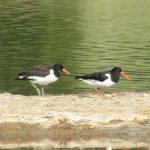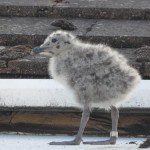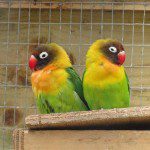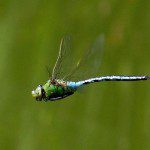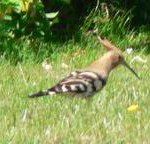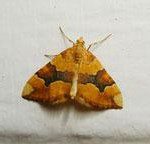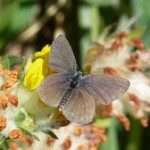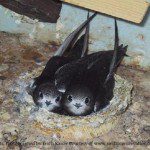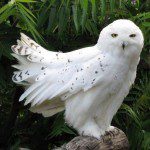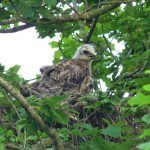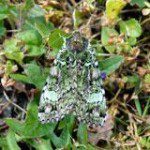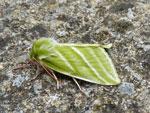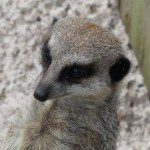Note: the following post is an online version of the Axe Estuary Birds Newsletter #135 dated 1st July 2010. Reproduced here with permission. See pics at the end of the post!
The Birds
No surprises that this was a quiet period for the local birders – this is always the least exciting part of the birders’ year. The hedges, trees and reed beds though are alive with recently fledged young birds, which is great to see indeed! Especially considering the worry I spoke of in the last newsletter of many nests being predated. Hopefully next month’s newsletters will have some more exciting bird news…
I said in the last newsletter than Green Sandpipers would be arriving soon, and they have! At least two are currently on patch, usually on Blackhole Marsh. The numbers will steadily increase from here on in, and will probably peak in mid July.
Small numbers of Black-tailed Godwits have been seen on the Estuary sporadically, with four on 22nd. There is a good chance these are non-breeding birds. A single Bar-tailed Godwit was also on the river on 22nd. The first Mediterranean Gull of the summer was on Blackhole Marsh on 28th, a first-summer bird.
Shelduck seem to have had a very good breeding season, with 47 young (of different sizes) counted on the river on 29th.
A very notable butterfly find during this period was of two sites for Small Blues. One on the Underhooken near Branscombe and another on the Undercliff near the harbour mouth.
Plenty of moth trap action during this period, it is approaching peak time now. There were some large catches, with the biggest being 367 moths of 70 species on the night of 29th. Here’s a few of my highlights during this period.. [Ed: see gallery]
The Trivia
Peter Vernon has been working his magic with a camera again, and captured this splendid Emperor Dragonfly in flight. [Ed: see gallery]
He also got this young Buzzard on its nest. [Ed: see gallery]
We have been blessed (?) with a new arrival. A pair of Herring Gulls nested on the roof, in spite of efforts to discourage them and in due course produced three chicks! Only one has survived, and found its way down on to our patio. The parent birds are very noisily protective, and going into the garden we would be well advised to wear a hard hat! Der Meisterringer von Axeberg (aka Mike Tyler) came to ring it, and took this photograph. Der Meisterringer was also called to Catherine Willerton’s house in Seaton on a similar mission. [Ed: see gallery]
Sue Smith has been to the Axe Vale Animals and Birds Park recently She says there so many things to see there – Eagle Owls, Meerkats, Wallabies and much more The couple running it are doing a wonderful job. Not to big and flat to walk on. Great for old and young. The park is on the A35 between Axminster and Honiton [see gallery for pics].
Sue also saw that the young Oyster Catcher at Black Hole Marsh appears to be doing well, as shown by this photo [see gallery]
Common Swifts like these youngsters will be setting off on their travels by the end of July, they’ll be back next t year but will not be mature enough to breed until 2014.
Sadly the population has crashed in recent years, there isn’t a simple answer but a comprehensive data base is the first step to finding a solution, to this end the RSPB has created a UK Swift Inventory of nest sites, low level “screaming parties” and nest boxes, if you know of or have seen any of the above please record them by visiting www.rspb.org.uk/helpswifts .
The RSPB in conjunction with other conservation bodies will use this information to produce a strategy to help Swifts by trying to protect existing colonies and to replace lost nesting places.
Please help us make sure that future generations can enjoy these summer visitors and their wonderful aerobatic displays. Any local problems Stephen.fitt@rspb.org.uk will try to help.
I managed to get to the Borrow Pit last week, and am most impressed with the extension to the Pond Dipping platform. There is much more room, and two seats!
Alan Jones tells of an exotic visitor—a hoopoe spent a few days in Payhembury this week! It may still be around.
Diary Dates
Every Tuesday, Thursday and Saturday from 10.00 a.m. to 4.00 p.m. Biodiversity Exhibition at the old TIC in Seaton’s Underfleet Carpark, with various informal walks and talks – more details at the Exhibition or phone 01395 517557.
This twice-monthly email newsletter is freely available to anyone who would like it, as is a periodic one about the activities of the East Devon Local Group of the Devon Wildlife Trust. Just send me an email with Axe Estuary Birds and/or East Devon DWT in the subject line. Also, for those without a computer, I will send a copy by post if you would like to send me some stamps.
Thanks to those who keep us informed – please continue to tell us of any unusual, interesting or amusing sightings, and what is about locally, and send any photos you would like to share.
Steve and David,
davidwalters@eclipse.co.uk. tel. 01297 552616 Mobile 0779 1541 744.
7 Springfields, Colyford, Colyton, EX24 6RE
A silly thought – if bird watchers are birders, are all moth watchers mothers? And what about bug watchers?


